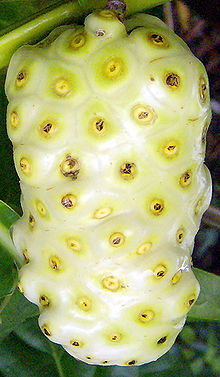Morinda citrifolia
| Morinda citrifolia | |
|---|---|
 | |
| Leaves and fruit | |
| Scientific classification | |
| Kingdom: | Plantae |
| (unranked): | Angiosperms |
| (unranked): | Eudicots |
| (unranked): | Asterids |
| Order: | Gentianales |
| Family: | Rubiaceae |
| Genus: | Morinda |
| Species: | M. citrifolia |
| Binomial name | |
| Morinda citrifolia L. | |
Contents[hide] |
[edit] Growing habitats
Noni grows in shady forests as well as on open rocky or sandy shores. It reaches maturity in about 18 months and then yields between 4–8 kilograms (8.8–18 lb) of fruit every month throughout the year. It is tolerant of saline soils, drought conditions, and secondary soils. It is therefore found in a wide variety of habitats: volcanic terrains, lava-strewn coasts, and clearings or limestone outcrops. It can grow up to 9 metres (30 ft) tall, and has large, simple, dark green, shiny and deeply veined leaves.The plant bears flowers and fruits all year round. The fruit is a multiple fruit that has a pungent odor when ripening, and is hence also known as cheese fruit or even vomit fruit. It is oval in shape and reaches 4–7 centimetres (1.6–2.8 in) size. At first green, the fruit turns yellow then almost white as it ripens. It contains many seeds. It is sometimes called starvation fruit. Despite its strong smell and bitter taste, the fruit is nevertheless eaten as a famine food[3] and, in some Pacific islands, even a staple food, either raw or cooked.[4] Southeast Asians and Australian Aborigines consume the fruit raw with salt or cook it with curry. The seeds are edible when roasted.
The noni is especially attractive to weaver ants, which make nests out of the leaves of the tree. These ants protect the plant from some plant-parasitic insects. The smell of the fruit also attracts fruit bats, which aid in dispersing the seeds.
[edit] Nutrients and phytochemicals

Noni fruit in Honolulu
These macronutrients evidently reside in the fruit pulp, as noni juice has sparse amounts of macronutrients.[6]
The main micronutrients of noni pulp powder include 9.8 mg of vitamin C per 1200 mg sample, as well as 0.048 mg niacin (vitamin B3), 0.02 mg iron and 32.0 mg potassium.[5] Vitamin A, calcium and sodium are present in moderate amounts.
When noni juice alone is analyzed and compared to pulp powder, only vitamin C is retained at a high level, 33.6 mg per 100 g of juice.[6]
Although the most significant nutrient feature of noni pulp powder or juice is its high vitamin C content, noni fruit juice provides only about half the vitamin C of a raw navel orange.[7] Sodium levels in noni juice (about 3% of DRI)[5] are high compared to an orange. Although the potassium content appears relatively high for noni, this total is only about 3% of the Recommended Dietary Allowance and so would not be considered excessive. Noni juice is otherwise similar in micronutrient content to a raw orange.[7]
Noni fruit contains a number of phytochemicals, including lignans, oligo- and polysaccharides, flavonoids, iridoids, fatty acids, scopoletin, catechin, beta-sitosterol, damnacanthal, and alkaloids. Although these substances have been studied for bioactivity, current research does not conclude anything about their effects on human health.[8][9][10][11][12]
These phytochemicals are not unique to noni, as they exist in various plants.
[edit] Possible medicinal properties
Noni has been evaluated unsuccessfully in preliminary clinical trials for possible use in treating cancer,[13] although the US National Cancer Institute has undertaken further preliminary studies for potential preventive effects against breast cancer.[14] Since 2007, there have been no other registered clinical trials on potential health benefits or anti-disease effects of noni[15] which remains scientifically undefined for any effect on human health.[14][edit] Traditional medicine
The green fruit, leaves and the root/rhizome were traditionally used to treat menstrual cramps, bowel irregularities, used to treat diabetes,liver diseases and urinary tract infections.[13][edit] Consumer applications
The bark of the great morinda produces a brownish-purplish dye for batik making. In Hawaii, yellowish dye is extracted from its roots to dye cloth.[16]There have been recent applications for the use of noni seed oil[17] which contains linoleic acid possibly useful when applied topically to skin, e.g., anti-inflammation, acne reduction, moisture retention.[18][19][20]


No comments:
Post a Comment